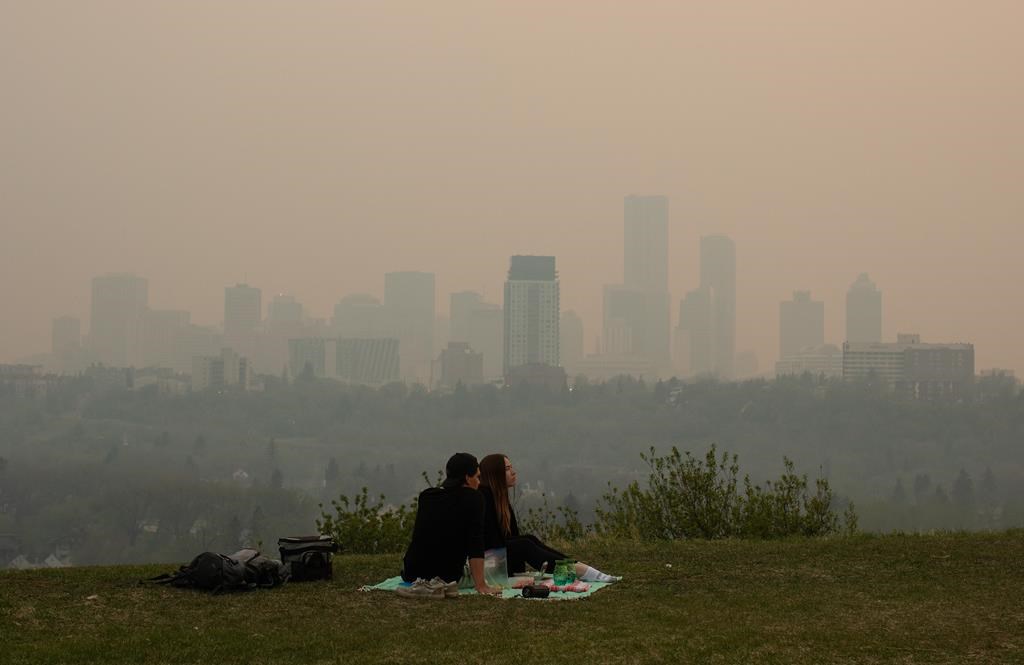Wildfires rage on across Western Canada

The latest bulletin from the Manitoba government says that blaze has grown exponentially from 30 square kilometres Saturday to its current size of 350 square kilometres, fed by windy conditions and extreme fire activity. The province says the community of Cranberry Portage, Man., 46 kilometres southeast of Flin Flon, is being evacuated.
“Approximately 500 residents are affected at this time, but that number may increase as conditions change,” the province’s statement reads.
The wildfire near Flin Flon has also damaged infrastructure in the area that could disrupt telecommunication, road and rail links, the province said, noting Highway 10 linking the city to Cranberry Portage is already closed.
Advertisement
READ MORE: Out-of-control wildfire near Flin Flon has grown 12 times bigger in a day: officials
The mayor of a northeast British Columbia municipality where thousands have already evacuated says his community is bracing for a “last stand” as high winds are expected to push a nearby wildfire directly toward the town.
Northern Rockies Regional Municipality Mayor Rob Fraser says there are about 37 households in Fort Nelson, B.C. and another 28 in the surrounding rural area which have not heeded an order to evacuate, totalling between 100 and 150 people.
Fraser is urging those residents to leave immediately, as Sunday evening’s forecast calls for stronger westerly winds that would push the Parker Lake wildfire just west of Fort Nelson into the town itself.
The wildfire, measured at 25 square kilometres in size, has moved to two or three kilometres away from Fort Nelson proper, and Fraser says crews and emergency workers are doing all they can to prepare in case the fire reaches town.
Advertisement
The wildfire threat facing Fort Nelson is just one of several out-of-control blazes across Western Canada, with fires also burning near communities in Alberta such as Fort McMurray and Grande Prairie. There is also an active wildfire near Flin Flon, Man., some 760 kilometres northwest of Winnipeg.
In Alberta, the Regional Municipality of Wood Buffalo has maintained an alert for Fort McMurray residents to be ready to evacuate on short notice, as the fire 16 kilometres to the southwest has reached 55 square kilometres in size.
“This wildfire grew substantially to the southeast yesterday, driven by strong winds,” Alberta Wildfire said in an update. “Fire behaviour is subdued this morning, but is expected to increase today as the temperature increases.”
In Grande Prairie, the nearby fire was 4 kilometres east of the community at 14 square kilometres in size.
The wildfires across Western Canada are also creating poor air quality in a number of regions spanning Manitoba to British Columbia, with Environment Canada reporting “very high risk” — or level 10-plus — on the air quality health index for Edmonton and Winnipeg as well as a number of small cities across the Prairies.
Advertisement
The weather agency said other communities seeing or possibly facing very high risk in their air quality today include Fort St. John, B.C.; Medicine Hat, Drayton Valley and Cold Lake in Alberta; and Swift Current, Sask.
In Yukon , telecommunications and 911 services have mostly been restored, government spokeswoman Julia Duchesne said at a Sunday news conference. A news release fromthe city of Yellowknife said disrupted services in the Northwest Territories had also been restored.
But Duchesne warned of possible future disruptions as the fire in B.C. rages on, adding the Alaska Highway remains closed and motorists need to consider alternatives such as the Stewart-Cassiar Highway.
Back in Fort Nelson, Fraser said the conditions in town are so smoky that people’s eyes start to get irritated as soon as they go outside. The poor air quality persists even indoors, he added.
But Fraser said the looming westerly winds are currently causing the most concern.
Advertisement
“Now that’s the exact worst-case scenario,” Fraser said of the projected winds, which are expected to increase to 20km/h before potentially producing gusts of up to 50 km/h by Monday. “The fire is 2 to 3 kilometres away, and if we get winds from the west anything like we did on Friday — the day that this fire sparked up — it’s going to be extremely difficult to keep it from moving into the community.
“Maybe (the wind) goes northwest, which will help to blow (the fire) south of the community. And that would really help us, but we’re as ready as we can be with the assistance from the province to make a last stand.”
In an update posted early Sunday, the Northern Rockies Regional Municipality warned all remaining residents to leave as fire risks “have escalated to a greater level.”
The update said the wind “has the real potential to significantly increase the size of the fires over the next 48 hours,” and Fort Nelson’s emergency operations centre itself will be relocated south later Sunday.
“Know that the decision to evacuate has not been made lightly and is based on careful assessment and expert advice, with the safety of residents being at the forefront,” the update reads.
Advertisement
“At this time, all residents who are currently remaining within the community are strongly urged to reconsider and evacuate immediately. You are our friends, family and neighbours. Please stay safe.”
This report by The Canadian Press was first published May 12, 2024.
Chuck Chiang, The Canadian Press